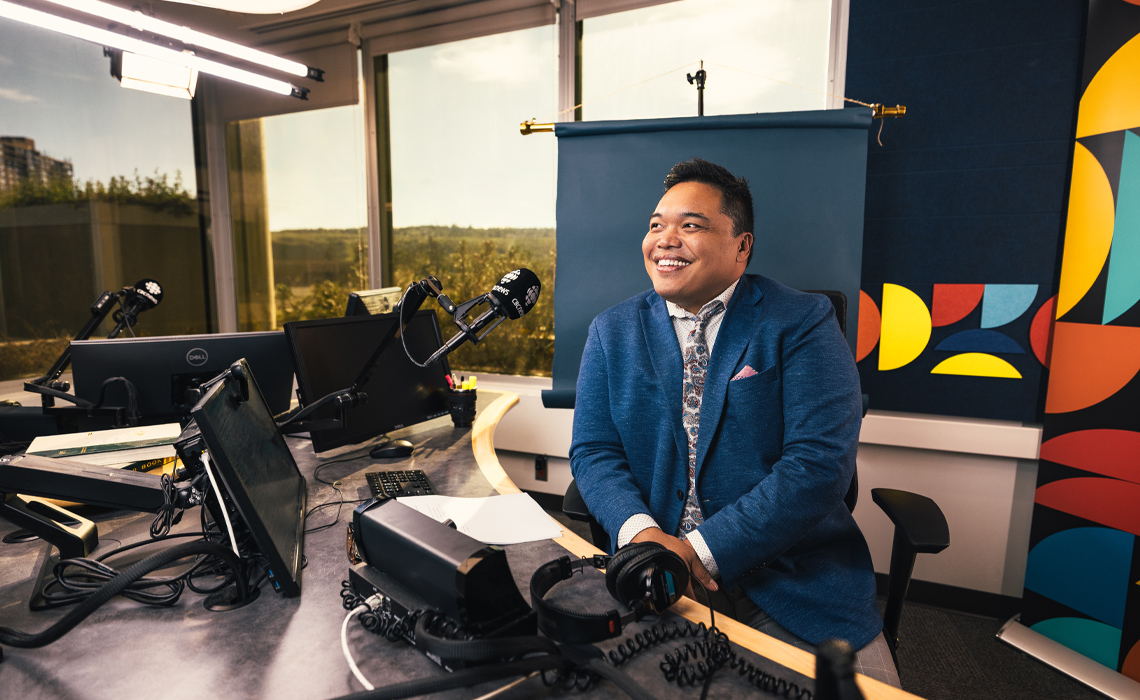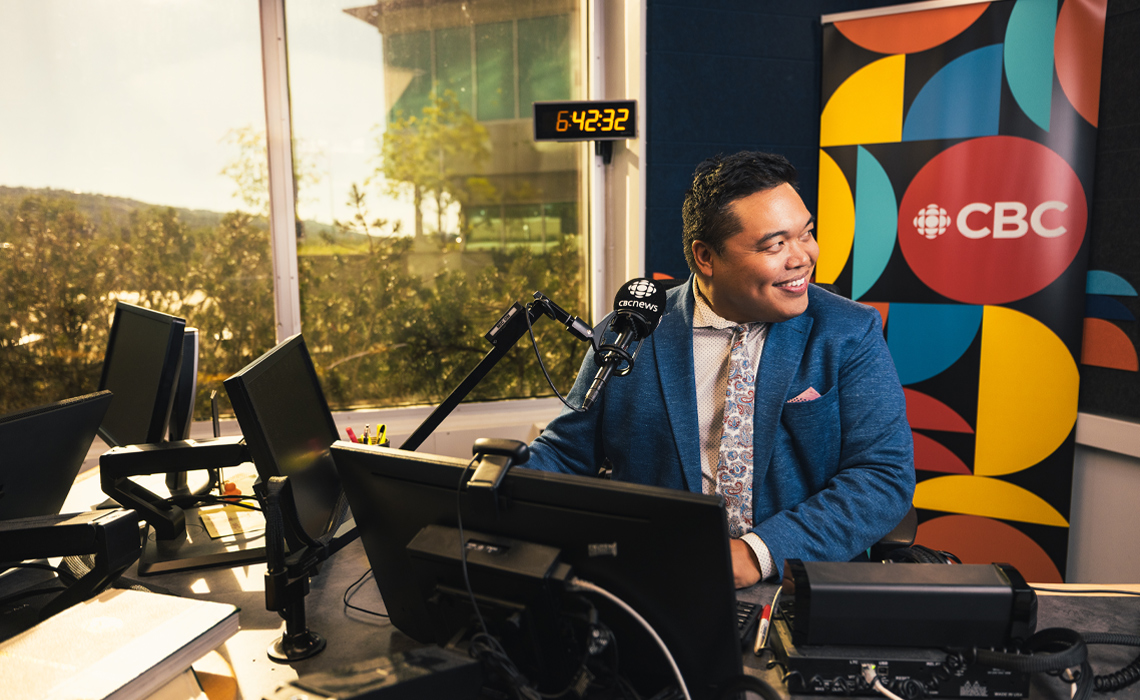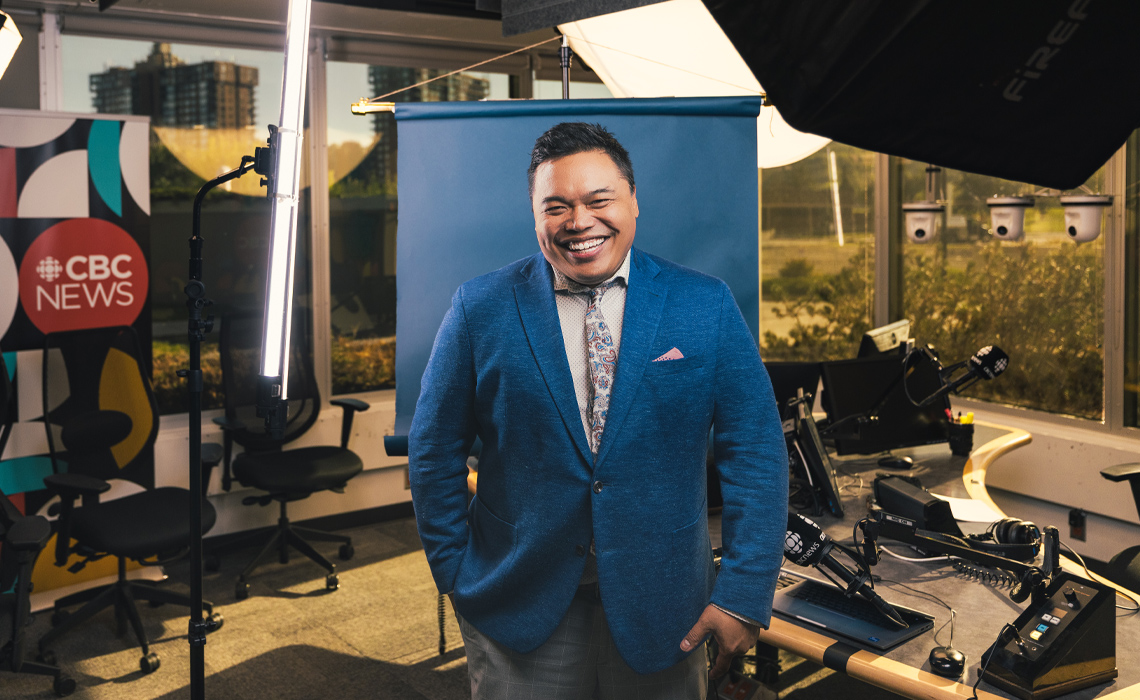The heart of the story

When Chris dela Torre first made it on air for CBC Radio One, he wasn’t reporting in a studio or newsroom. He was in a pigpen.
Tasked with covering summer festivals in the province, he found himself in Buffalo, AB, surrounded by small children chasing a greased-up pig. The piece aired on The Eyeopener and it was a hit. Scrappy. Surprising. Full of life.
Now host of Calgary’s The Homestretch and more than 20 years into his career, dela Torre has built a reputation for capturing exactly that kind of moment: ordinary scenes turned unforgettable through sound, curiosity and heart.
A love of sound
Broadcasting wasn’t the original plan. After high school, dela Torre played in a band with dreams of chasing a music career. At his parents’ urging for a back-up plan, he enrolled in journalism at Mount Royal. While the idea of writing for a magazine like Rolling Stone was appealing, after a year of study he took some time off to reassess.
“I was still very interested in interviewing and I still wanted to be around not just music, but also sound. I love the idea of telling a story with sound,” he says. “So that led me to Mount Royal’s broadcasting program and I loved it.”
One of his instructors, who was also a CBC journalist, encouraged him to apply for a summer gig as a festival reporter. It was part street team and part storyteller, swag in one hand and a mic in the other.
And that’s how he ended up in Buffalo. One greased pig story later, he was hooked.
Finding his frequency
After graduating, dela Torre started his CBC career in the middle of a lockout, picketing alongside veteran journalists.
Bit by bit, he carved out his place through a mix of jobs — from giving museum tours and setting up Christmas trees to guest hosting and producing — until he found his voice behind the mic.

“Once I got my foot in the door at CBC, I quickly realized that there's nothing else like it in Canada,” he says. “There's not many other opportunities where you can tell stories in this way.”
He sharpened his hosting skills filling in on national shows like q and The Story from Here. In 2017, he moved to London, ON, to help launch a new CBC station and took the helm as host of Afternoon Drive. He spent five years there, working alongside the same instructor who had helped him get that first summer gig.
Coming full circle, he returned to Calgary to take over CBC’s afternoon radio show The Homestretch, stepping into the seat vacated by local legend Doug Dirks and co-hosting with Jenny Howe, both fellow Mount Royal alumni.
Stories with a pulse
So what makes a good story?
“I think a good story has stakes. It usually has tension. But more than anything, there's emotion. That’s the thing that draws me in,” says dela Torre.
He recalls advice from an early mentor: don’t shy away from the tough stuff during an interview, but always wear a smile, even if they can’t see it. “Because on the other end of that microphone is another human being,” he says. “And people can feel when you’re being real.”

That’s his north star. Whether it’s property taxes or provincial politics, he’s always looking for the human core.
“If you can get to the heart of what it means to the human beings involved and the human beings listening to it,” he says, “that’s where the real story is.”
And sometimes, that story is just plain ridiculous in all the right ways.
The geese that went global
“I think the story that most people know me for, and that I will probably never be able to live down, is the story of the geese,” he says.
In 2012, while biking to work, he was ambushed by a pair of territorial Canadian geese. They chased him. He swung his bike in self-defence, seizing the brakes in the process. He walked into work an hour and a half late.
His colleagues kept insisting he tell the story on air and when he finally did, it exploded. Blogs picked it up, awards followed. And to this day, it still resurfaces.
“For better or worse, it turned out really good,” he laughs. “I feel like it has a life of its own.”
That’s part of radio’s magic, he says. Sometimes, the best stories come from the smallest, strangest, most human moments. Off-the-cuff banter. A mispronounced word. A goose fight.
“You can’t reverse engineer a viral moment. If you're lucky enough, great,” he says. “But I think all you can do as a broadcaster, especially in live radio, is be as prepared as possible and hope for genuine, authentic moments.”
The human connection
Despite advancing technology and shifting platforms, the heart of the job remains the same.
“The basics of radio have not changed much,” he says. “It’s true for TV and podcasting, too. It’s about building a genuine connection with your guest, and always thinking about your listener.”
And radio, he says, is still the most accessible way to do it.
“You don’t need a subscription or a fancy smartphone. You could literally have your grandpa’s AM radio. If you still have that thing and it can turn on, you can tune into our show.”
He’s still struck by the bond between host and listener.
“One of the strangest things about our job is that we don’t see the people we’re talking to,” he says. “But it’s amazing to meet folks — in a grocery store, at an event — who say you’re part of their day. Some of them have been listening since I was in my 20s, just out of Mount Royal. That’s a really beautiful thing.”
Stories still to come
Even with nearly two decades behind the mic, dela Torre isn’t done.
These days, he’s thinking more about his own family’s story. “I feel like there’s a much larger project there,” he says of his parents’ immigration from the Philippines in the late ’70s. “The culture shock. The racism. The hard-won resilience.”
Until then, you’ll find him on the air every weekday, helping Calgary head home just a little more connected.
“It comes down to knowing what matters to the person you’re talking to,” he says. “If you can figure that out — what they care about, what they’re afraid of, what makes them angry — you’re off to a good start. From there, it’s just one human talking to another. That’s what makes it work.”

